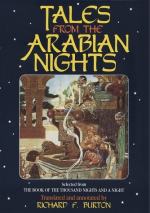[FN#199] I understand this as the cupbearer who delights the five senses.
[FN#200] In the original we have, “Saith the Sayer of this delectable narrative, the strange and seld-seen (and presently we will return to the relation full and complete with its sense suitable and its style admirable), anent what befel and betided of Destinies predestinate and the will of the Lord preordinate which He decreed and determined to His creatures.” I have omitted it for uniformity’s sake.
[FN#201] Meaning “The easy-tempered.” Scott (vi. 354) writes “Sohul.”
[FN#202] In text “Litam"=the mouth-band for man: ii. 31, etc. The “Mutalathsimin” in North Africa are the races, like the Tawarik, whose males wear this face-swathe of cloth.
[FN#203] “Drowned in her blood,” says the text which to us appears hyperbole run mad. So when King Omar (vol. ii. 123) violently rapes the unfortunate Princess Abrizah “the blood runs down the calves of her legs.” This is not ignorance, but that systematic exaggeration which is held necessary to impressionise an Oriental audience.
[FN#204] For this allusion see vol. v. 191.
[FN#205] This physical sign of delight in beauty is not recognised in the literature of Europe, and The Nights usually attributes it to old women.
[FN#206] In text “Hima"=the private and guarded lands of a Badawi tribe; viii. 102.
[FN#207] In text “Daylaki.”
[FN#208] A small compact white turband and distinctive sign of the True Believers: see vol. viii. 8.
[FN#209] [The words in the text seem to be: “wa Talattuf Alfazak wa Ma’anik al-hisan"=and for the pleasingness of thy sayings and meanings so fine and fair.—St.]
[FN#210] [The Arabic seems here to contain a pun, the consonantic outline of “Tasht"="basin” being the same as of “tashshat"=she was raining, sprinkling.—St.]
[FN#211] In Arab. “Ya Warid”: see vol. iii. 56.
[FN#212] The growing beard and whisker being compared with black letters on a white ground.
[FN#213] In the text these seven couplets form one quotation, although the first three rhyme in ——aru and the second four in--iru.
[FN#214] This “diapedesis” of bloodstained tears is frequently mentioned in The Nights; and the “Bloody Sweat” is well-known by name. The disease is rare and few have seen it whilst it has a certain quasi-supernatural sound from the “Agony and bloody sweat” in the Garden of Gethsemane. But the exudation of blood from the skin was described by Theophrastus and Aristotle and lastly by Lucan in these lines:—
—Sic
omnia membra
Emisere
simul rutilum pro sanguine virus.
Sanguis
erant lachrymae, etc.
Of Charles ix. of France Mezaray declares “Le sang lui rejaillait par las pores et tous les conduits de son corps,” but the superstitious Protestant holds this to be a “judgment.” The same historian also mentions the phenomenon in a governor condemned to die; and Lombard in the case of a general after losing a battle and a nun seized by banditti—blood oozed from every pore. See Dr. Millingen’s “Curiosities of Medical Experience,” p. 485, London, Bentley, 1839.




